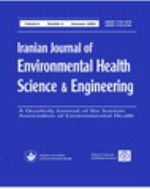
|
Iranian Journal of Environmental Health, Science and Engineering
Iranian Association of Environmental Health (IAEH)
ISSN: 1735-1979
Vol. 6, No. 3, 2009, pp. 187-194
|
 Bioline Code: se09028
Bioline Code: se09028
Full paper language: English
Document type: Research Article
Document available free of charge
|
|
|
Iranian Journal of Environmental Health, Science and Engineering, Vol. 6, No. 3, 2009, pp. 187-194
| en |
Aero-Bacteriological Study Of Vegetables Market At Jabalpur
Pathak, A. K. & Verma, K. S.
Abstract
Urban and rural vegetable markets of India characterized by mass activity with a little sanitary measure are responsible for generation of higher quantity of aerosols containing biotic and abiotic components. The aerosols generated in due course of mechanical disturbance, contain many organic compounds enable to sensitize vital respiratory organs of local inhabitants. Inhalation of airborne microorganisms can expose workers to risks from infection, toxicosis and allergy. The presence of non-spore forming gram-negative bacteria in air due to the mechanical areosolization indicates higher rate of dissemination of pollutants in these occupation associated areas. The present aero-bacteriological investigation included enumeration, identification and numerical analysis of different types of culturable airborne bacteria with inhalable fraction of gram-negative bacteria in the vegetable market of the city of Jabalpur, in order to measure the degree of aerobiopollution for this environment. The aero-bacteriological sampling has been done fortnightly for a period of one year. Samples were cultured based on standard methods. The survey revealed that in this type of atmosphere, environmental factors were responsible for the persistence of airborne bacteria with variable effects. The major contributors for aerosol generation were other mechanical activities, since this site is classified under human activity-enriched and highly trafficked site. The bioload of this atmosphere was recorded as high as 2.9 x 103 bacterial carrying particles per cubic meter during winter, dominated by both inhalable and non inhalable fractions of gram-negative bacteria. In summer, soil-borne bacteria were reported dominant in the air. High humidity and low temperature were the major factors for dissemination and distribution of gram-negative bacilli. A regression model with upto 43% variance was prepared in order to predict the bioload for this atmosphere in relation to meteorological parameters.
Keywords
Aerosolization, Aero-bacteriological investigation, Gram-negative bacteria, Vegetable market
|
| |
© Copyright 2009 - Tehran University of Medical Sciences Publications
Alternative site location: http://diglib.tums.ac.ir/pub/
|
|
